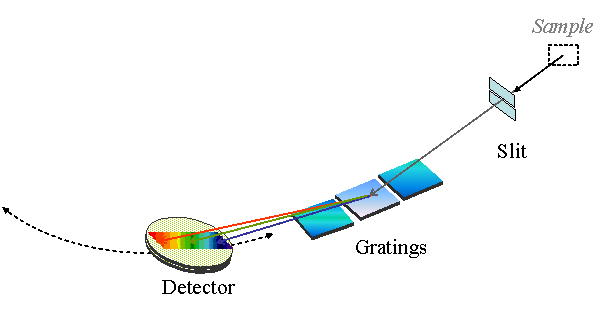
Dr. Mark Boots BEng, BSc, PhD
Chief Information officer at STARS, Saskatoon.Education
- University of Saskatchewan
Saskatoon, Saskatchewan
B.E. in Engineering Physics
May 2008 - University of Saskatchewan
Saskatoon, Saskatchewan
B.Sc. in Computer Science
September 2008 - University of Saskatchewan
Saskatoon, Saskatchewan
Ph.D. in Physics
Sept. 2012
Current Affiliation
- Chief Information officer at STARS, Saskatoon..
Ph.D. Thesis
- Designing and optimizing gratings for soft X-ray diffraction efficiency
Projects

To support the research being done by the other members of our research group, I'm working with David to develop a pretty wicked X-ray Emission Spectrometer for the REIXS beamline under construction at the Canadian Light Source.
Diffraction Grating Efficiency
Almost all spectrometers used in the soft X-ray range must use diffraction gratings to disperse and select light of a specific wavelength/energy. The trouble with soft X-rays, though, is that they tend to be absorbed by pretty much anything they hit. (That's actually why they're so useful in material science, because their photon energies correspond to core electronic transitions in common elements like Carbon, Oxygen, Nitrogen, etc. and light metals.)
Because of this, it's difficult to make mirrors and gratings that efficiently reflect soft X-ray light (ie: that don't suck it all up, and actually leave some for the scientist to shine on their sample or detector). In practical terms, if you can figure out how to increase the efficiency of gratings by "x" %, you can enable the scientists who use the beamline to do "x" % more experiments in the same amount of time. On the flip side, since a grating's resolution and efficiency are usually at odds with each other, you could also let them do the same number of experiments, but with higher resolution.
By modeling and characterizing the performance of difraction grating designs, we're setting out to make the world's brightest and highest resolution spectrometer, in one single machine. By considering both resolving power and efficiency at the same time, David and I were able to make quantified, intelligent design compromises in the optical design. The optical design and mechanical design are now complete, and we're in the final stages of assembling and comissioning the beamline for operation in Summer 2010.
The Nephiere project is a set of software tools that I'm developing to model the diffraction efficiency of reflection gratings.
Beamline Controls and Instrumentation
Recently I've been spending a lot of my time on engineering and instrumentation challenges that are necessary to get the beamline running. Here's a snapshot of some of these projects. The source code for all of the software projects is available on my git repository and is licensed under the GNU GPL.Hardware Projects
- SA02-Z: a tiny, modernized replacement for the 4-channel fast preamplifier used by the Quantar 2400-series multi-channel plate detectors and position analyzers. [project page coming soon]
- USB24010: A $30 USB interface to connect Quantar's 2400-series position analyzer to a personal computer. [project page coming soon]
- MrSteppy: An a "step and direction" motion controller for controlling up to 8 stepper motors. A software driver for the EPICS distributed control system used at the CLS is also provided.
Software Projects
- EPICS drivers for the PI M810-series Hexapods
- EPICS drivers for MrSteppy, your friendly neighbourhood motion controller.
- EPICS drivers for a variety of controllers, vacuum pumps and gauges:
- SRS (Stanford research systems) IGC100 Ion Gauge Controller
- Varian Turbo-V 301-AG turbo pump controller
- MicroIon Plus (Granville Phillips) Ion Gauge and Convection Gauge Controller
- Lakeshore and Heatwave Labs 101303 temperature controllers
- Kimball Physics Inc. EGPS-1017B Electron Gun Power Supply Controller
- Acquaman: The Comic-book Hero of Synchrotron Science since 2011. (A revolutionary program for beamline data acquisition and scientific data management) [in progress]
- Realtime documentation
- git repository
ALS Beamline 8: Data Acquistion and Processing Software
I spent the summer of 2006 on Beamline 8 of the Advanced Light Source, learning about the control systems and instrumentation techniques used on XES beamlines. While I was there, I worked on a new hardware interface for the spectrometer's stepper motors and multi-channel plate detector. I also created some new software for measuring and processing X-ray Emission spectra.
In 2007, I started working on the control systems for the REIXS spectrometer. I've released part of this software as a standalone program for processing XES data. The program is called "sxedaq" (Soft X-ray Emission Data AcQuisition), and it supports:
- ALS BL8.0.1 (.info|.imge|.spec) file format
- Experiment documentation and cataloguing
- Plotting and comparison of multiple spectra
- Spectral post-processing for detector efficiency and grating curvature
- Energy-axis calibration by changing the central detector energy and detector angle
Publications
- M. Boots, D. Muir and A. Moewes, Optimizing and characterizing grating efficiency for a soft X-ray spectrometer , J. Synchr. Rad. 20, 272-285 (2013).
